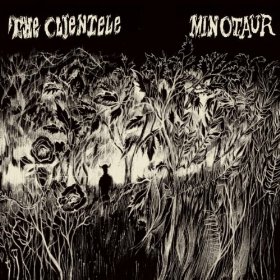
The Clientele
Minotaur
(Merge; 2010)
By Andrew Hall | 23 September 2010
As far as contemporary British guitar bands go, the Clientele are still essentially the best in their genre. Even if their second album, Strange Geometry, may have been an unassailable career high—a record on which urban alienation, reverb, strings, and Alasdair MacLean’s stunning yet understated guitar work came together to yield something so much greater than its parts—their output over the last five years has been consistently engaging and slowly, subtly changing. MacLean’s playing has gotten increasingly psychedelic, Mel Draisey’s joining in 2006 gave them a new set of textures and a fullness they never had before, and the band’s songs have become increasingly extroverted, singing not just about loneliness and feeling lost but also picking up girls and the effects of being dosed with acid.
Minotaur, the band’s first mini-album, continues this trend, though it feels less like development and more like a companion piece to Bonfires on the Heath. This record consists of eight songs that the band recorded around the same time, deemed worthy of their album, then shelved for a year. And fans of the band’s back catalog, but especially God Save the Clientele (2007) and Bonfires, will find a lot to love here, even if musically there are few left turns.
Minotaur‘s title track is driven by picked acoustic guitar as MacLean retells, in fragments, the myth of Theseus and the minotaur; but nothing about this stands out as much as Mel Draisey’s string work in the chorus. Through the magic of multitrack recording the band places two distinctly different parts—one much higher than the other—across the song’s stereo field, and the counterpoint that carries the song from chorus back to verse is a strikingly effective earworm. “Gerry” is also more an exercise in texture, with the Glenn Branca-esque guitar work in the bridge proving its best moment. “As the World Rises and Falls,” a West Coast Pop Art Experimental Band cover, fits in perfectly with the band’s sound, with Draisey’s piano work taking the source material (which has clearly informed the band’s work) and making it theirs again.
The two most interesting moments here are the two least expected, “No. 33” and “The Green Man.” The former is an instrumental piece built out of a reverb-heavy piano arrangement, building to the latter, the band’s second spoken-word piece. MacLean picks up the mini-album’s mythology theme again, this time over a field recording of trains, doors, droning machinery, and wind. He narrates of dust and of abandoned objects, and the combination of the two comes out so much more haunting than it has any right to be; this should fall under “self-parody,” but it somehow works. It also renders “Nothing Here is What It Seems” almost an afterthought despite its strengths.
While Minotaur is a fine collection of songs, it doesn’t feel like a definitive closing on the book of the Clientele, which the band has hinted it might be. MacLean will be pursuing his other project, Amor De Dias, in the near future, and the band has talked vaguely about being done following Bonfires and its subsequent touring. It’s difficult to tell where the Clientele could move next as a band, as their last two and a half albums have pushed at such a specific sound that its palette does almost feel exhausted here. However, they’ve proven themselves able to change drastically in the past—so, even though Minotaur is one of their lesser works, I can’t help but hope that a band as consistently transcendent as the Clientele will continue on into the future.





